
Interview with artist Yuki Saito. Please enjoy reading the second half of this interview by the FFD editorial team!
Interview with artist Yuki Saito. The boy who preferred to draw than to speak went on to become a popular artist (part 2)
Saito’s drawings are extraordinary, but his oil paintings are devastating
I passed the first part of the examination for Geidai (Tokyo University of the Arts. Founded in 1887, it’s Japan’s only national comprehensive university of the arts, and the best fine arts university in Japan), which was the drawing part. But I failed the second part, which was the oil painting section. The same thing happened when I took the entrance exams for the first time straight out of high school, and again the next time.
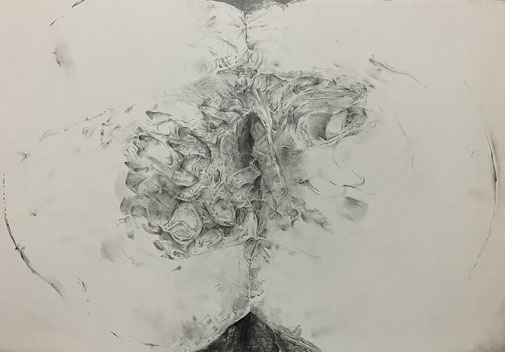
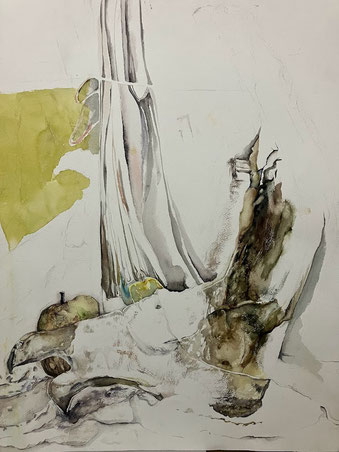
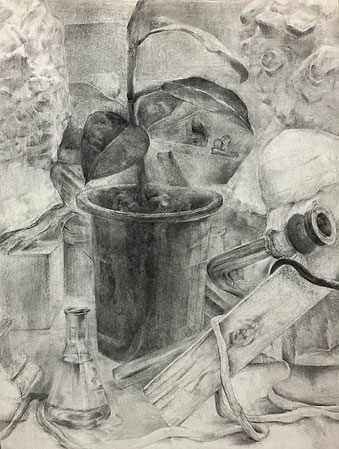
Your drawings were always extraordinary, but it was the oil paintings that kept you from passing the entrance exams?
That’s right. I attended the Saikosha Art Institute (a well-established arts prep school in Saitama). Even amongst other older students there, my drawings received high praise.
Back in my high school art club, I would spend weeks working on a single piece of art. But at the prep school, I was trained to draw in a shorter period of time and felt like I had grasped something in my own way.
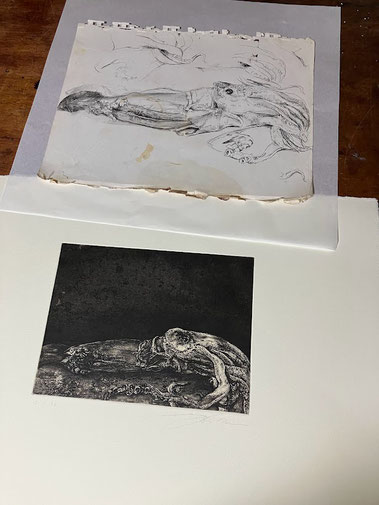
However, when I did oil paintings, my teacher would say to me, “Saito, when you work with oil, the ‘Hakaider’ (a pun, based on the popular TV animation villain named ‘Kikaider’, and the work hakai, meaning destruction) in you comes out.”
‘Hakaider’?
It obliterates the oil painting.
I didn’t like the fact that oil paints took too long to dry in the limited amount of time I had. Maybe my desire to paint more didn’t suit the medium. At the age of 20, I’d never thought about ‘making the most of paint materials’.
I honestly thought that I wasn’t suited for art school entrance exams. After all, I could only paint what I really wanted to paint. My personal obsession at the time was doing self-portraits.
No… You couldn’t have painted a self-portrait for the entrance exam…?
Obviously, I failed across the board. But painting something I didn’t want to paint was too stressful, and my body couldn’t concentrate long enough to paint. I learned that lesson the hard way. Another thing I learned was that a part of the creative process is making sure I’m motivated and in a state of mind to concentrate before I even pick up a paintbrush.
That’s an interesting point of view if it’s about a work of art rather than an entrance exam.
From the university’s point of view, I guess they were trying to say, “There’s no point in going to college. You should stay at home and paint.”
Aah, I see.

Luckily, I was accepted to Tokyo Zokei University, where the exam assignment was to paint a self-portrait. I ended up attending Tokyo Zokei University (private art university in Hachioji, Tokyo).
Being exposed to various techniques at a young age is invaluable as a painter
At Zokei University, I attended the painting department and went to class every day,
Did you start copperplate engraving in college?
Going back in time a bit, I started copperplate engraving itself when I was a 17 year old high school student. I found a picture that I liked in a textbook, with the caption “copperplate print”.
The same day, I went to the library and checked out a book on copperplate engraving, and started doing it on my own. I shaved a copper plate and figured I could print engravings with that.
My high school had an etching press, but I didn’t know how to use it. So I thought I would just keep the copper plates and print them when I got to college. I was hanging on to five or six copper plates that I had shaved.
Were you taught how to use the etching press as part of your college classes?
Not exactly. In sophomore year of college, I went into the printmaking classroom and started using the etching press on my own. The students in the printmaking majors came inside asking, “Why’s this interesting kid here?”, and wondered who I was. They showed me how to use all the tools, and I eventually became friends with the printmaking majors and even the professors there.

The university sounds very open across various majors.
I guess that’s true. At college, it wouldn’t be uncommon to see people doing printmaking next to someone doing oil paints or doing silkscreening. The person working with the silkscreen could easily ask their neighbor if they could “hold the other side for a moment while I do the silkscreen?” and the student oil painting would help out.
Being immersed in that kind of environment, it’s natural to discover how silk screening is done, as a student of another major. I watched the process of various techniques up close, and somehow was able to accumulate the knowledge over time.
What a great learning environment.
Yes, it was a fantastic learning environment, although I remember the classrooms could be very messy. I guess no one could organize it when it got to that point.
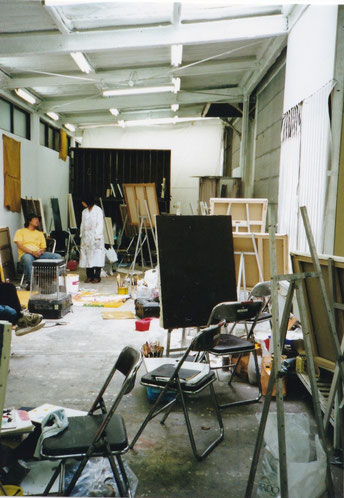
I also did some Nihonga and photography. In photography, I developed film. Students who find skill in this field would go on to do photography majors. The freshmen get to experience across a range of fields this way. In their sophomore year, each student declares their major. The majors were divided into “figurative”, “conceptual”, and “print”. In our junior year we develop our skills and techniques, and in the senior year, we create a project for our graduation.
Your university decides majors at a much earlier point than other art schools.
I believe so. I’ve heard that at Musashino Art University, for example, people decide on their majors in their junior year.
Did you major in print?
Yes, I had already decided on doing printmaking in college when I borrowed the copperplate print book from the library at 17.
I also thought, “By the time I graduate, I would be able to do woodblock, copperplate, lithography, and silkscreening”, hence my decision to major in print. Because of my experience from those days, I still print my New Year’s cards by silkscreen.
I also print goods with woodblocks. I still remember how to do it, though obviously not at the level of an expert. You gain valuable insights by being exposed to skills and techniques in other fields. I think that as an artist, you’re less likely to get stuck in the long run if you’re trained in other areas as well.

Copperplate engraving from my college days, Mugenkei (Infinite scenery), (95 x 75cm).
Entering contests in college
You amassed techniques during your college years, and applied it to create your art. As a high school student, you presented your work on top of bookstores. How did you present your work during college?
I coordinated with my friends on campus and did exhibitions at Bumpodo (a well known art supply store founded in 1887, in Kanda, Chuo-ku, Tokyo). Saying that I organized it makes me sound like I was the leader, but it was because I was the only male student amongst the students majoring in print. I was outnumbered, and thus put in charge of the administrative work and organizing.
I also did exhibitions outside the university. The National College Print Exhibition was held at the Machida City Museum of Graphic Arts in Tokyo, and if several of us at our university were selected, we could present our major works there.
If you won an award, that meant that your work would be purchased and housed in the museum, although the prizes were given to just 30 people in the nation. Such an award would be a highlight of an artist’s career.
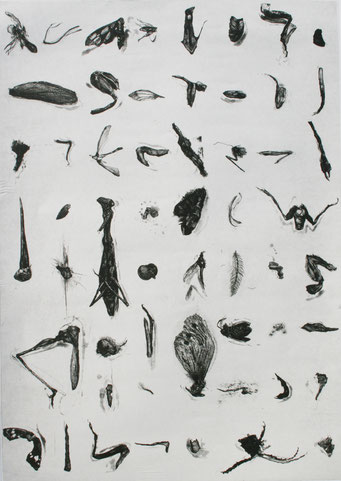
The museum also offers ‘small works’ for sale. Collectors of prints from all over Japan rush to the museum before they sell out, so the first day of the exhibition every year gets exciting.
It’s been a great opportunity for me. I sold one of my early works to a collector back then, and the collector has continued to buy my works.
I used to think it would be good to sell large works at the exhibition too. I thought that it would be a great confidence booster for an aspiring art student. If you win an award, the museum buys a piece, but a print is not limited to one. This would be a good way to learn about pricing in the real world.
Unfortunately, we weren’t allowed to sell large works. Perhaps it was because the exhibition involved various universities, which made it difficult to come to an agreement.
During my first overseas challenge…!?
I entered my work in international contests as well as domestic ones. I thought that I could compete on the basis of my work alone, since there were no limits due to what grade I was in, or the confines of my school. I also wanted to know if my work would be evaluated differently depending on the country or the culture it was presented in.
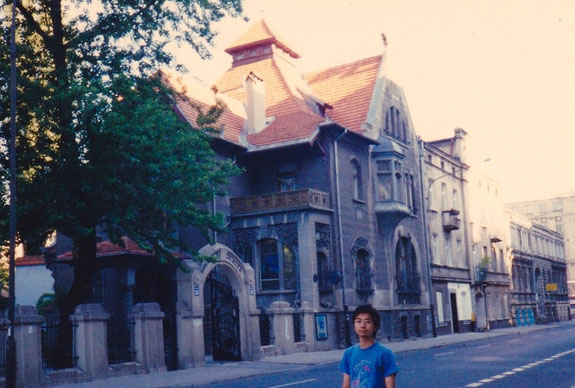
For any current art students that may be reading this interview, would you mind telling us about the process of applying to international contests?
You can start by searching the internet using keywords such as ‘print triennial’ or ‘print biennial’, which will give you a lot of hits. You print out the summary guidelines in black and white, and leave them out on your desk at the university. It may be in English, but the critical information such as size and deadline will be evident. You can ask around and see if anyone would be interested in submitting it together”, then you can collect the ones that are completed by the deadline. It’s easy to send prints by mail. You don’t need a frame, so if you bring it to the post office and send it by EMS (International Speed Post), and divide up the cost by 5 or 6 people, it’s fairly inexpensive.
I usually entered contests that didn’t charge any entry fees. If your work was selected, you would receive a catalog with your work in it. I was a junior in college when I won a grand prize at my first contest entry.
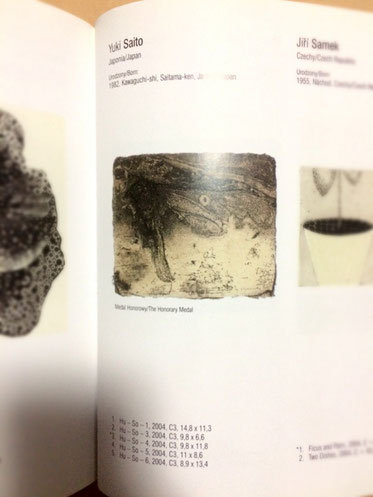
You won an award while still in college?
Yes. The interesting thing is that sometimes, a college junior like me could win a prize, while a veteran artist in Japan might not be selected. They don’t make distinctions between amateurs and professionals overseas because it doesn’t matter there.
I see.
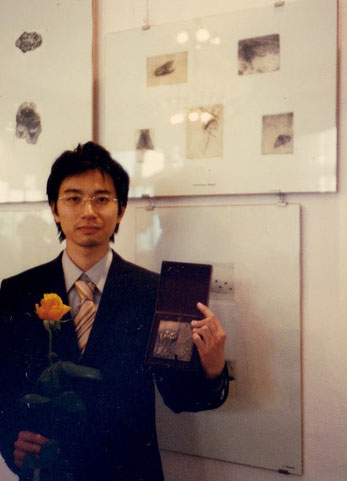
I continue to keep in touch with my teachers who taught me these things. I have so much respect for them as my mentors and senior artists. I had a very meaningful and interesting experience as a college student.
When my professor found out that I’d won the award, he told me,
“From today onwards, I no longer consider you as a student”, implying that he thought of me as an artist, and I still remember to this day how happy that made me feel.
He also gave me advice to keep all my receipts and file them with your tax returns.
What was your art style like at that time?
It was like the piece you bought from me a long time ago, Ga no Shigai (moth carcass).
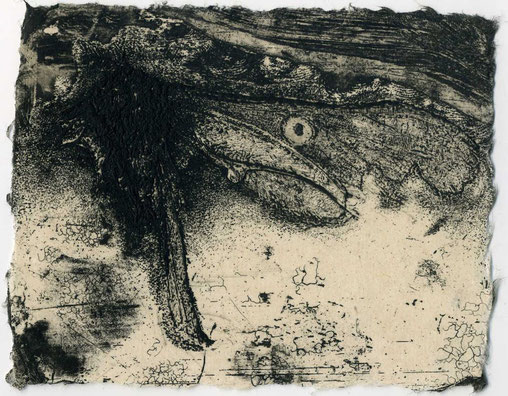
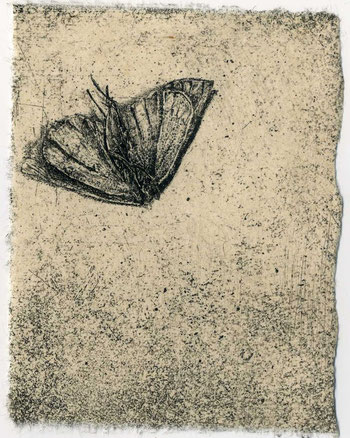
I didn’t know the print was from that period. I bought it because I thought it was an unusual print.
That piece, the Ga no Shigai (moth carcass) was one of the five entries I sent to Poland, and that was the one that won the grand prize.
I see. I’ve heard that you used to collect such insect carcasses; was that when you were a student?
I kept a carcass of a moth in my desk drawer.
I collect and make observations on things that draw my interest. I try to think about how it looks to me, and how I would express it. That’s been my style.
Meeting new people through the contest
What did you do once you graduated from university?
My meeting you at Fukufukudo was also a part of me applying to art competitions!
So it was. I guess it was at the Art Debutante in 2010 that your piece was selected? (Art Debutante was an open competition held from 2010 – 2017, backed by Saitama Shinbun, organized by Fukufukudo. The judges were not from educational institutions but had backgrounds as art sellers at department stores, art dealers, and newspapers)
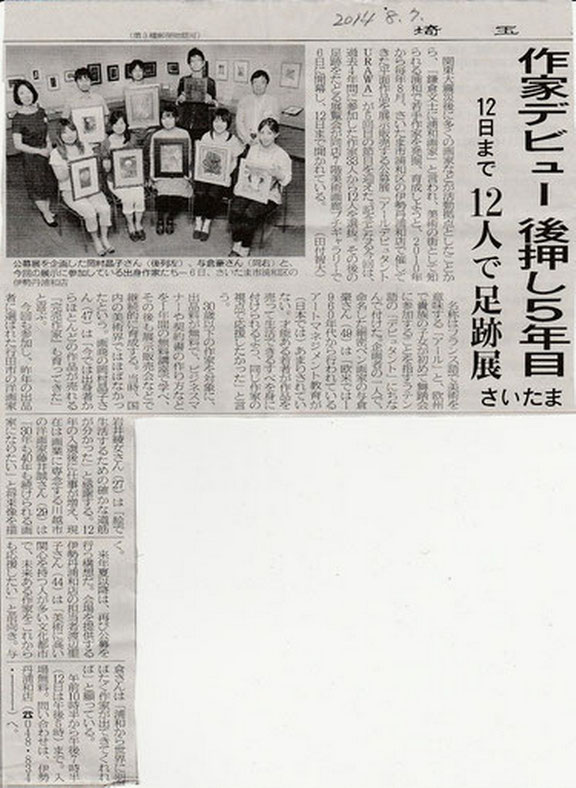
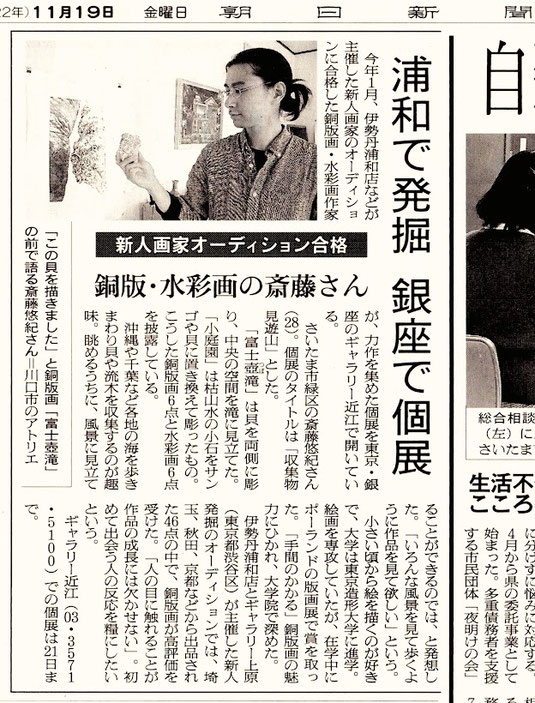
Saito, who had been working specifically toward more open exhibitions since his participation in the Art Debutante, explains his reasons for doing so: “I always want to follow the path that my art leads me to. Relatives and friends will see your art because “it’s you”. Peers and experts will see your art “through their own special knowledge”. The rest of the people are simply interested in “the art” at first, then they meet me. As an artist, my work has to move the viewer on its own. That’s incredibly challenging, but it’s also the reason my work helps me to expand my confines, taking me to unknown frontiers.
Yes, I was interested in getting reactions for my work from those who didn’t know me, to have my work being seen by people I wasn’t expecting. So, without knowing anything about the design industry, I submitted my work to competitions sponsored by companies such as Recruit.
When I received business cards from other exhibitors, one of them was an employee and an artist of Hakuhodo.
I recall asking him “Do you work for a company called HAKUHODO?” and him giving me a blank look. I feel a little bad now that I realize he must have handed me his business card with pride and confidence.
I was that naive — or perhaps I should say that I was fearless. (Hakuhodo is a major advertising agency. Dentsu, Hakuhodo, and Asatsu-DK are referred to as the top 3 advertising in Japan).
Hakuhodo and Fukufukudo are totally different!
The judges consisted of designers across various fields. I submitted a large print of a row of insect carcasses. It was selected as a finalist in the public competition, in which only 10 were chosen and the first place winner would hold a solo exhibition. I came in third place and was involved in design related work for the following three years. I designed a cup and saucer with flies around a monkey carcass, a hand towel covered with barnacles, etc. It looks painful to wipe your hand with it, don’t you think?
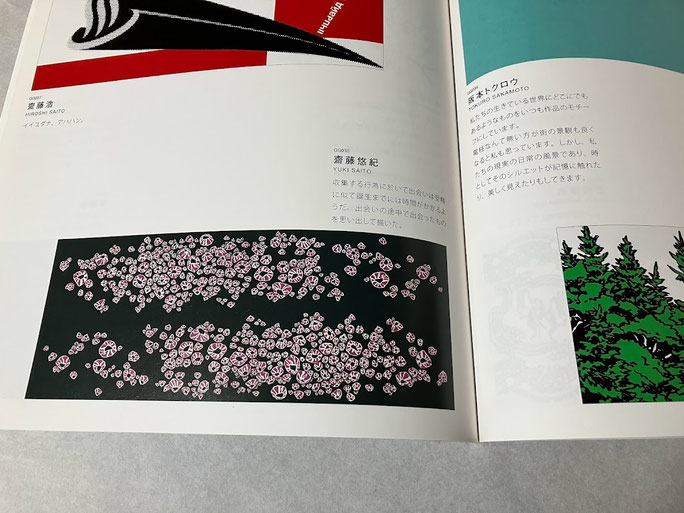
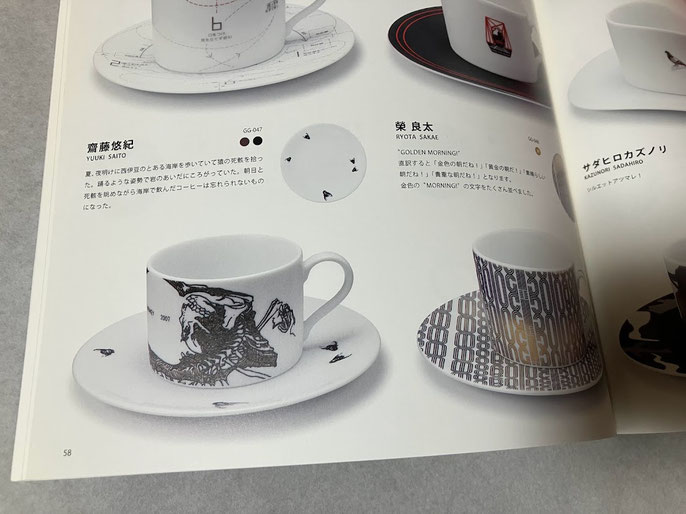
Hahaha
I hope to someday be able to organize and hold such an exhibition. It would be interesting to display the original artwork and the goods side by side. The customers would find it very interesting, and it would provide a way for unheralded artists to gain recognition and popularity.
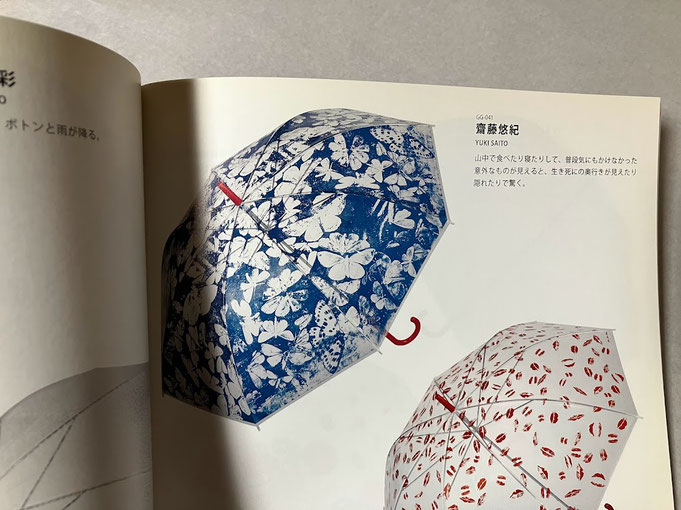
I think it aligns with the spirit of prints. Prints have an element that makes them easy to incorporate into daily life. Something that makes one think, “Let’s try hanging this on the wall for a moment”.
A painting is an experience that brings you into contact with the artist’s deep world itself. It can be both poison or medicine.
Designed items have a more casual but different appeal.
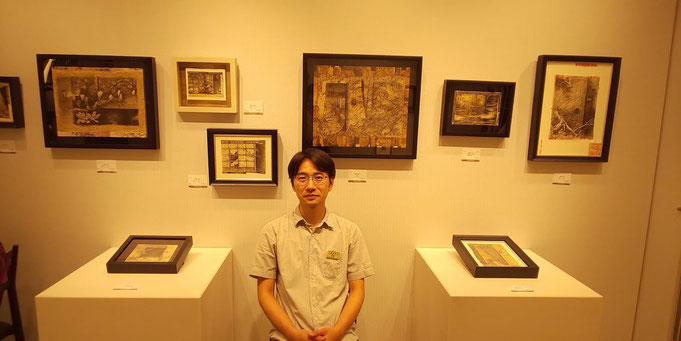
I believe that the fundamental allure of a painting’s soothing presence has not changed since ancient times. I feel there’s an underlying desire to see something that’s there, that makes our hearts tremble.
At the same time, I sometimes wonder what form it will take when we think about “hanging a painting”. I feel that it’s necessary for painters to have the strength to survive, even if the form of hanging a painting changes.
Even with the same piece of art, there can be a difference in the way the art is perceived depending on how it is presented.
I guess that’s the part where we, the art galleries, have to exert our power. I think you’re right.
(FFD editorial team)
Copperplate engravings of Danpen (Fragments), arranged in a row, a study of history, interview
Yuki Saito produced the Fragments series of copperplate engravings in the 2000’s. We examine these series of works over time in the form of an interview.
When we take a fresh look at and study the meaning of past works, we sometimes find a close relationship with the art and society, or discover a new way to appreciate the art. We hope to introduce such ways of enjoying art to our readers and to broaden the base of art collectors.
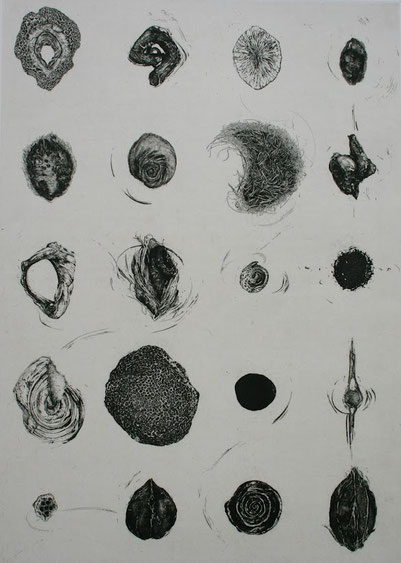
This work is from the time when Saito started collaborating with a friend after completing graduate school and sharing a studio with the artist. This is one of a series of copperplate engravings made from fragments of shells, stones, seeds, skeletons, etc., collected on beachcombing trips.
Fragmented shells, skeletons, seeds, and stones. Each had its original form and background. Shells and bones have been turned into fragments, but are still here and lined up even though they’re far from their original form. How was Saito able to create this kind of work?
“I was attracted to these fragments at the time, even though I didn’t understand why — at least less than I understand now. But I knew that I was drawn to them and that I wanted to study them.”
At the time, he says, his work was valued for its collectable and anatomical point of view. “But now,” he thinks that he was “drawing for a different reason”.
“I thought that the reality for us was based on the fact that these fragments had lost their original form, but were still lined up together.”
We have others and ourselves, and society is made up by asserting and retracting our opinions and beliefs. Some are physically wounded by battle, and some of us lose our homes. We are damaged by the environment around us, and that experience is what makes us ‘whole’.
“I believe that art is reality itself. I think it represents society.”
The reality is that we cannot live in the form in which we were born into. We can’t live as a baby. People in society live in a line even after they’ve been broken down to fragments, as in this piece of work. That’s the beauty of this work.
I think this is what attracted Saito to create this work.
“This Fragment series is something that’s taken 10 years for my reflections to catch up with my art, and it’s something I would like to tackle again in the future. The reaction when I present it isn’t very strong… I wish I were better at expressing myself.”
Saito said, scratching his head.

(FFD editorial team)
Artist Yuki Saito bio, awards, and exhibitions

Yuki Saito
<Bio>
1982 Born in Saitama
2008 Completed Design Education and Research Field, Tokyo Zokei University, Graduate School of Fine Arts
<Museums>
Japan, USA, China, South Korea, Taiwan, France, Poland, Romania, Spain
<Department Stores>
Ginza Mitsukoshi, Isetan Urawa, Isetan Shinjuku, Tokyu Tama Plaza, Fukuya Hatchobori, Hanshin, Tobu Ikebukuro
Exhibited at galleries nationwide.
Layered glass paintings and copperplate printing
<Recent Exhibitions>
2022 Yoru to Hana (The night and flower), Takatsuki Hankyu
Layered glass painting, copperplate engraving, Art Zone Kaguraoka, Kyoto
Yobanashi, Art Gallery Muse, Gunma
Geppo, Fukuya Hatchobori Main Building
2021 Mijikayo, Isetan Urawa
2020 Yakou, Fukuya Hatchobori Main Building Gallery 101
2019 Kunpu, Hanshin Umeda
Yukikau, Isetan Urawa
2018 Miruna no Zashiki, Ginza Mitsukoshi
2017 Hikari no Ito, Isetan Urawa
Nowo Shitamu, Tokyu Department Store Tama Plaza
2016 No aida, Isetan Shinjuku
Aketate, Isetan Urawa
Hone no Mori no Naka de, Yanagisawa Gallery, Saitama
Hitoma no Hyouhaku, Art Gallery Muse, Maebashi
2014 Stranding Cafe, Sawyer Cafe, Nishi-Ogikubo
2013 Byou-Byou, Yanagisawa Gallery
2012 Kansoku Goya, Gallery Uehara, Shibuya
Tadayou Tenkyu, Isetan Urawa
Kansoku, Youseido Gallery, Ginza
<Awards>
2009 The International Space Triennale Print Exhibition, Purchase Prize, Seoul Museum of Art, Korea
2007 PRINTS TOKYO 2007, Special Judge Prize , Tokyo Metropolitan Art Museum, Ueno
2005 The 5th International Mini-Print Biennial Cluj, Honorable Mention, The Art Museum of Cluj-Napoca, Romania
The 12th International Mini-Print Triennial Lodzi, Honorable Mention, Willa Gallery, Poland
<Public Collection>
Willa Gallery, Museum of Cluj-Napoca, Tokyo Zokei University library (Hachioji), Urawa Art Museum (Saitama), Kanuma Municipal Art Museum of Kawakami Sumio, Machida City Museum of Graphic Arts, National Taiwan Museum of Fine Arts (Taiwan), MECCA DESIGN GROUP (Korea), Manga Museum of Japanese Art and Technology (Poland)
Description of Yuki Saito’s work 2, Yoru no Sukima – Hana no Nioi – (Multi-layered Nights -scent of flowers-)
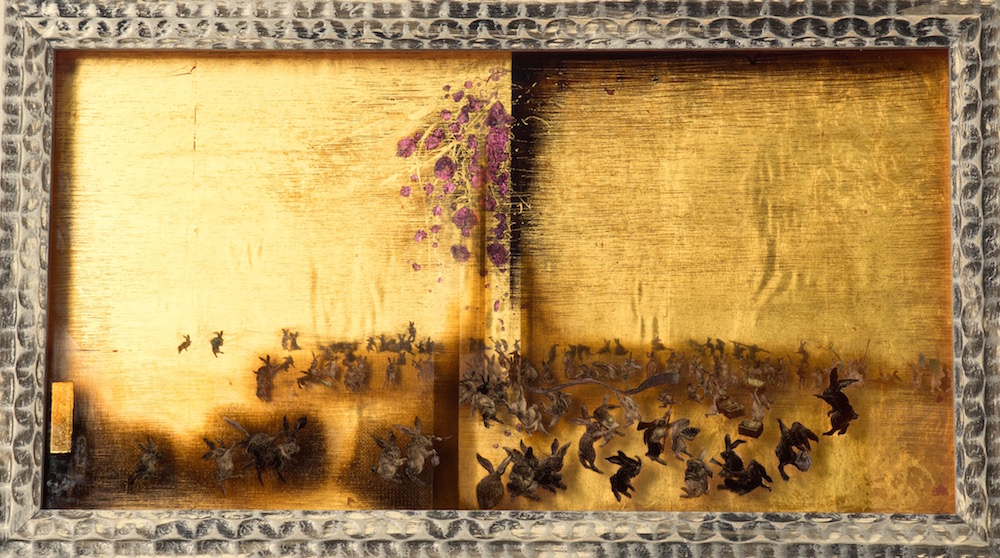
Multi-layered Nights – scent of flowers – is a popular work in Yuki Saito’s layered glass painting series.
I’ve heard that Westerners like to shut their door tight to create a private space and even get naked inside the room, but that such a thing never happens in Japan, where there’s a famous saying “A wall has ears and a shoji has eyes”.
Unlike western doors, Japanese fusuma (sliding doors) are not airtight. The humidity and climate probably gave birth to this Japanese style of design. Even when separated by a single fusuma, one can feel the presence of the otherside. That’s the interesting aspect of a Japanese shitsurae.
This isn’t referring only to person-to-person issues, such as nudists, but also about the connection between nature and the Japanese people. Japanese shitsurae means watching the shadows of leaves fall on the shoji screens, to love the voice of birds and insects, and to feel the fragrance of the flowers carried by the wind. The Japanese shitsurae is not only about functionality but is also linked to the culture.
This artist creates layered glass paintings, but glass paintings originated in the Netherlands. He has learned Western techniques and uses them to depict Japanese culture.
In Yoru no Sukima – Hana no Nioi – (Multi-layered Nights – scent of flowers-), the artist depicts the scent of ume (plum) blossoms drifting through the night, just as the scent of weeping ume blossoms seep through from behind a sliding door.
The artist emphasizes the link between Japanese shitsurae and Japanese culture through the use of layered glass painting.
(description by FFD editorial team)
Details of Yuki Saito’s exhibition
Coming soon.